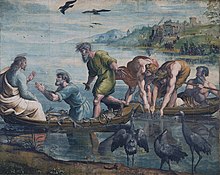Cardboard (art)
In the fine arts, cardboard is a template in original size for frescoes , mosaics , stage sets , lead glazing or woven carpets , which are created by the artist and serve as templates for execution in the respective techniques. This can be implemented in factories .
This method is chosen for fresco paintings because work is carried out quickly on the fresh plaster , which requires a well-developed preliminary drawing.
Cardboard boxes were often kept after the implementation, either to serve as a template for a further implementation that was planned from the outset (for example for tapestries that were to be produced in larger numbers) or as security, in case of damage, e.g. B. to restore a window or a wall painting. Therefore, boxes of long-destroyed works of art have been preserved. On the other hand, due to their large size, cardboard boxes were always at risk of being damaged or "disposed of" for reasons of space.
tapestry
In picture knitting , such a pattern has been attached to the loom under the warp threads since the Middle Ages and serves as a guideline for the weaver . In the illustration of Petri Fischzug by Raphael, one can clearly see the grid that the image makers used to delimit their respective work.
The boxes of Peter Paul Rubens for the tapestry in Cologne Cathedral (usually only shown at Easter or Christmas time) or for the triumph of Maria Medici are for their part considered masterpieces.
literature
- Durs Grünbein, León Krempel, Klaus-Peter Schuster (eds.): The gods of Greece: Peter Cornelius (1783 - 1867); the cardboard boxes for the frescoes in the Glyptothek in Munich from the Nationalgalerie Berlin , on the occasion of the exhibition The Gods of Greece, Peter Cornelius (1783 - 1867), the cardboard boxes for the frescoes in the Glyptothek in Munich from the Nationalgalerie Berlin , Haus der Kunst, Munich , 10. September 2004 to January 9, 2005; Alte Nationalgalerie Berlin , 2005, with illustrations by Peter von Cornelius (= SMB-DuMont ). DuMont-Literatur-und-Kunst-Verlag, Cologne 2004, ISBN 978-3-8321-7503-0 .
University publications
- Rudolf Freiherr Hiller von Gaertringen: Raphael's learning experiences in Perugino's workshop: Cardboard use and motif adoption in the course of change (= art studies . Volume 76), Deutscher Kunstverlag Munich / Berlin 1999, ISBN 3-422-06242-4 (dissertation University of Tübingen 1996, 431 pages with numerous illustrations 27 cm under the title: Aspects of Raffael's learning experience in Perugino's studio ).
Web links
- Cardboard in: The large art lexicon from PW Hartmann
